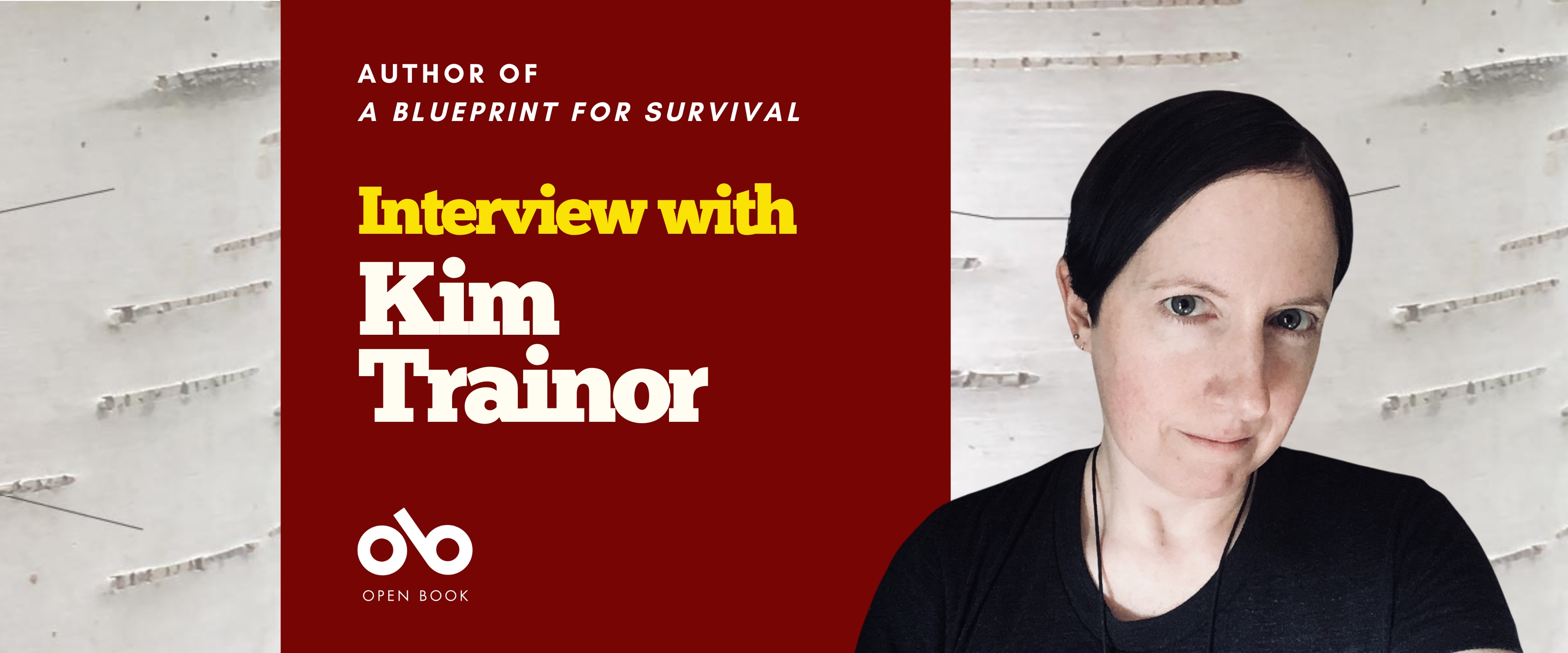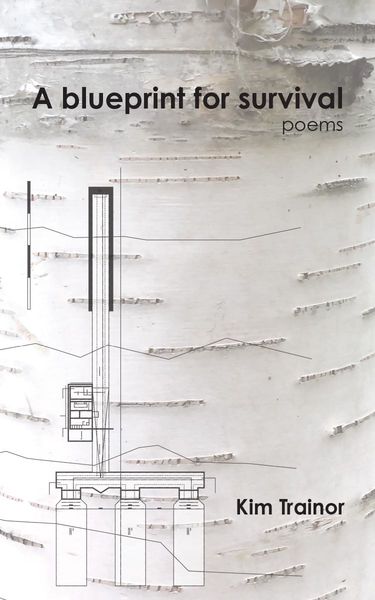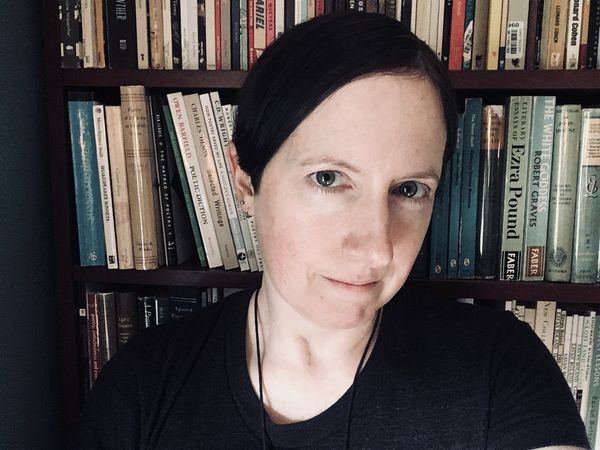Kim Trainor's New Poetry Collection Gives Readers a Blueprint For Survival
Whether an expression of love or loss, of hope or fear, a collection of poetry can frame the most important happenings of our time and give readers a pathway through them.
The poems in A Blueprint For Survival (Guernica Editions) by Kim Trainor begin in wildfire season, and follow the path of a long-distance relationship set against the backdrop of climate change in the boreal landscape. They then shift into a series of "Seeds," all of which consider resistance, survival, and emergence in the face of global catastrophe. Each of these seeds are a blueprint, whether human-made tool or complex organism, that show the reader a different way of being in the world.
This in an essential collection, and a series of poems for this era of climate crisis. Trainor's words pulls the reader along as the book explores the very DNA of living things, the "beautiful cells" we find in lentils and snowdrop, codex and tardigrade, salmon and honeybee.
Read more about A Blueprint For Survival in this thought-provoking Line & Lyric Interview with the author.
Open Book:
Can you tell us a bit about how you chose your title? If it’s a title of one of the poems, how does that piece fit into the collection? If it’s not a poem title, how does it encapsulate the collection as a whole?
Kim Trainor:
A blueprint for survival is taken from a special 1972 issue of The Ecologist that was trying to draw attention to our path, already seen clearly at that time, towards environmental planetary destruction. While the topic is existential, I love the hope embodied in the word ‘blueprint,’ which suggests a model or path forward towards survival. The first section of the book, “Wildfire,” documents a long-term relationship against the background of increasing ecological devastation and wildfires – a baseline – while the second section, “Seeds,” is a long sequence that thinks about forms of resistance, survival, and emergence in the context of the sixth mass extinction. I was thinking of each seed/poem as a blueprint, (metaphorically, each ‘seed’ is either a simple human-made tool/activity/group or a complex organism driven by its DNA to adapt to and respond to our current existential threat), and each seed shows a different way of being in the world: lentil, snowdrop, chinook salmon, codex, tardigrade, honeybee, “the beautiful cell,” among others. The Vespa orientalis, for example, as noted by Robert Bringhurst in Learning to Die, has evolved a band of the obscure pigment Xanthopterin to draw sunlight out of air and generate a small voltage. The endangered chinook salmon travel thousands of miles to their spawning grounds in the Fraser River and feed the rich coastal ecosystem. Tiny houses, mobile wood frame cabins outfitted with solar panels, are being built by the Tiny House Warriors in unceded Secwépemc Territory in the interior of BC to challenge the construction of the Trans Mountain pipeline. The connection is serotiny – some organisms require heat, fire, burning, in order to thrive.
In particular, I loved the tiny advertisement inside my Penguin copy of the book, that reads:
FURTHER INFORMATION: Organizations wishing to join the Movement for Survival and all others seeking further information should write to the Acting Secretary, The Movement for Survival, c/o The Ecologist, Kew Green, Richmond, Surrey.
Sending off an inquiry to join a Movement for Survival that is advertised at the back of a copy of The Ecologist—that’s hope!
Your CanLit News
Subscribe to Open Book’s newsletter to get local book events, literary content, writing tips, and more in your inbox
OB:
Was there any research involved in your writing process for these poems?
KT:
Mostly for the second section. For each poem I often did a lot of searching for information on the chosen artefact or organism. For example, for “The Beautiful Cell (I-glass)” I was trying to find out all the many kinds of translucent sea creatures. For “Silene Stenophylla (Svalbard Seed Vault)” I researched seeds and seedbanks, with a particular focus on the Svalbard Seed Vault, a global repository meant to preserve seeds in the face of catastrophe. It’s a back up for the many seed vaults around the world that are often subject to destruction, such as the seed bank in Aleppo, where seeds had to be smuggled out in jars during the civil war, or the ones in Afghanistan, in which the Taliban simply poured the seeds out onto the ground in order to steal the plastic bottles that held them. I have a filing cabinet packed with folders of images, magazine articles, academic articles, one for almost every poem.
OB:
Is there an individual, specific speaker in any of these poems (whether yourself or a character)? Tell us a little about the perspective from which the poems are spoken.
KT:
While we might argue that any lyric poem presents a mediated persona, I’d say when an ‘I’ appears in this book, it is myself. But as I progressed through writing the second sequence, I began to think about the perspectives of more than human kin and how a lyric poem might approach their perspective (not re-present or speak for them, but approach them, in their own being.
OB:
Was there a question or questions that you were exploring, consciously from the beginning or unconsciously and which becoming clear to you later, in this collection?
KT:
I began writing this collection around 2017 when the wildfire season became increasingly noted. I was traveling intermittently between Vancouver and Edmonton, and in Edmonton I experienced at different times both a polar vortex and such thick smoke from wildfires burning out of control in British Columbia that it was almost impossible to see a few metres in front of you. I began to play with the idea of wildfires and serotiny and seeds while working in the Centre for Interdisciplinary Science at the University of Alberta. When I visited Edmonton, I’d go there to write at one of the desks in the upper foyer, next to the articulated skeleton of a plesiosaur that floats there in space, a reminder of the brevity of our time on earth, the extinction events of the past, and of how quickly we have changed the earth. Humans have existed on earth for only a flicker of breath and yet we’ve almost destroyed the planet in that time.
OB:
What are you working on next?
KT:
I’ve just finished a manuscript called Blue thinks itself within me: Lyric poetry, ecology, and lichenous form. It will appear with Oskana Poetry and Poetics (University of Regina Press) in Spring 2026. It uses my time spent as an activist at Ada’itsx / Fairy Creek as a way to think about the relationships between lyric poetry and ecology, and how the lyric poem might allow us to imaginatively consider more than human kin. Related to this is a long poem, a book-length project on Fairy Creek, that I am just beginning to think about. I don’t yet know what form it might take, but I’m considering oldgrowth specklebelly lichen as a model.
___________________________________________________
Kim Trainor is the granddaughter of an Irish banjo player and a Polish faller who worked in logging camps around Port Alberni in the 1930s. Her earlier books are Karyotype (Brick Books, 2015), Ledi (Book*hug, 2018), shortlisted for the Raymond Souster award, and A thin fire runs through me (icehouse poetry / Goose Lane Editions, 2023). Her poems have appeared in Anthropocenes (AHIP), Ecocene, ISLE, Ecozon@, Dark Mountain (UK) and Fire Season I and II (Vancouver). Her poetry films have screened at Zebra Poetry Film Festival (Berlin) and at +the Institute [for experimental art] (Athens), as well as in Dublin and Seattle. Her current project is “walk quietly / ts’ekw’unshun kws qututhun,” a guided walk at Hwlhits’um (Canoe Pass) in Delta, BC, featuring contributions from artists, scientists, and Hwlitsum and Cowichan knowledge holders.







